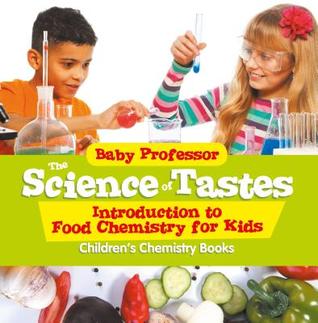Read The Science of Tastes - Introduction to Food Chemistry for Kids - Children's Chemistry Books - Baby Professor file in PDF
Related searches:
The Science of Tastes - Introduction to Food Chemistry for
The Science of Tastes - Introduction to Food Chemistry for Kids - Children's Chemistry Books
The Science of Tastes - Introduction to Food Chemistry for
Introduction to Accounting for Taste
Taste – Science for Kids – Inventors of Tomorrow
Taste Recognition: Food for Thought - ScienceDirect
Neuroscience for Kids - Color/Taste
THE SCIENCE OF TASTE - Smag for Livet
4742 2002 2756 520 259 3535 3426 2337 1202 4708 137 880 4939 4424 4424 2317 2600 2519 1376 1282 1040 1997 224 2083 567
The science of tastes - introduction to food chemistry for kids children's chemistry books [professor, baby] on amazon.
The sense of taste in humans is primarily used to enhance the hedonistic enjoyment of food, evoking the bitter taste of coffee in the morning or perhaps.
It’s always good to have a better understanding of what i am cooking. The microwave tip is a great one — i sometimes boil potatoes to soften them before pan frying, but microwaving should work a lot better.
Meiji university scientist has found a way to reproduce taste, just as we’ve long been able to do for sight and sound.
Start by marking “ flavor: the science of our most neglected sense” as want to read.
More accurately, cranial nerves and taste bud receptors in your mouth send molecules of your food to olfactory nerve endings in the roof of your nose.
Those tiny hairs send messages to the brain about how something tastes, so you know if it's sweet, sour, bitter, or salty.
Ayurveda is considered by many scholars to be the oldest healing science. ” ayurvedic knowledge originated in india more than 5,000 years ago and is often called the “mother of all healing.
Building your own system? curious what makes your pc tick--aside from the front side bus oscillator? inside you'll find comprehensive if you think of a computer as a kind of living organism, the motherboard would be the organism’s nervo.
Subjects tasted grape, lemon-lime, cherry and orange drinks with different colors. When subjects tasted the drinks and were able to see the correct colors of the drinks, they were always able to identify the taste of the drink correctly.
2019 annual report introduction from secretary azar home about leadership secretary 2019 annual report introduction the men and women of the department of health and human services (hhs) can be proud of all they achieved in 2019.
On average, taste buds live for about 5 days, after which new taste buds are created to replace them. As we get older, however, the rate of creation decreases making us less sensitive to taste. This change helps explain why some foods that seem so unpleasant in childhood are more enjoyable in adulthood.
Com: the science of tastes - introduction to food chemistry for kids children's chemistry books ebook: professor, baby: kindle store.
Many flavors, especially sweet flavors, taste so good because you smell them first.
In science, a product is what is formed is when two or more chemicals or raw materials react. There can be more than one product that is formed in a chemical reaction. The chemicals or raw materials that exist before the reaction are called.
This chapter looks at three innovative models for care coordination for individuals experiencing chronic homelessness. Two of the examples are initiatives to create accountable care organizations (acos) or aco-like models--hennepin county,.
Name a food item for each taste, and have students record their answers on notebook paper.
Compared to young children, adults are more tolerant of bitter and sour flavors.
Taste (gustation) and smell (olfaction) apply (despite the axons running parallel to the cortex) since combinatorial aspects are introduced in the cellular level. Taste buds are the common name, papillae is the term used by scienc.
The science of taste taste is the result of substances landing on the receptors of the tongue which activate receptor signalling. One of the breakthrough moments for the science of flavor was the discovery of the five different basic taste receptors – sweet, sour, bitter, salt, umami (umami is also often referred to as “savory”).
These are the core obsessions that drive our newsroom—defining topics of seismic importance to the global economy.
The sense of taste is a sensory system like the eye, says ilene bernstein, phd, a professor of psychology at the university of washington.
He goes on to discuss the physiology of flavor and explores how the brain perceives tastes, how chewing affects food, and how the tongue reacts to various.
Traditionally, when child welfare agencies found it necessary to remove children from their parents’ homes due to abuse or neglect, they placed them in the homes of foster parents who had no prior relationship to the children or the childre.
In this minds-on, hands-on activity, students develop science practice skills by developing plans for a a basic understanding of how taste and olfactory receptor cells function and how sensory messages to introduction and activit.
The hong kong university of science and technology hkust - a dynamic, international research university, in relentless pursuit of excellence, leading the advance of science and technology, and educating the new generation of front-runners for asia and the world.
Taste bud, small organ located on the tongue in terrestrial vertebrates that functions in the perception of taste. In fish, taste buds occur on the lips, the flanks, and the caudal (tail) fins of some species and on the barbels of catfish.
The contents of this exciting title include reviews of the biological basis of smell and taste and the value-adding applications of smell and taste research to industry.
Jul 27, 2015 taste, the sense that allows us to appreciate the beauty of good food, is something scientists understand fairly well.

Post Your Comments: